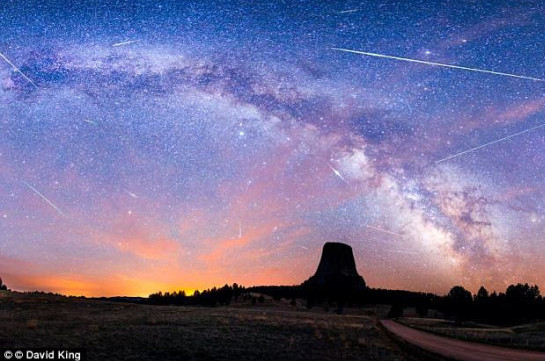
01/05/2020 17:46
Eta Aquariids meteor shower to fill the sky with dozens of shooting stars an hour this weekend ahead of the peak on Tuesday (video)
The next meteor shower to light up the sky will be the Eta Aquariids and it will see dozens of shooting stars per hour this weekend - ending at the peak on Tuesday, The Daily Mail reports.
Eta Aquariids are created from the debris left behind by Halley's Comet and happen every year from the middle of April until the end of May.
They will be visible over the weekend where a dozen meteorites will be visible per hour but on Tuesday night this will go up to 40 or more per hour during the peak.
Astronomers say to watch the shower you should 'get a comfy chair' and be prepared to sit outside for hours - but you won't need binoculars or a telescope.
The Eta Aquariids are named after the constellation Aquarius as they fall from that point in the sky and specifically the star Eta Aquarii.

'For the best conditions, you want to find a safe location away from street lights and other sources of light pollution,' according to the Royal Museums Greenwich.
The meteor shower will be best viewed in the southern hemisphere but will be visible in the northern hemisphere - just not as clearly.
The Moon will be in its waxing gibbous phase during the peak of the shower but it will be below the horizon before dawn and shouldn't damper the viewing.
When out watching them don't just stare in on direction as you might miss the brightest and most impressive shooting stars off to the side.
The best way to watch for them, according to NASA, is to lie on your back and look straight up as it gives you the widest view of the sky without getting neck strain.
Meteors are pieces of debris that enter the atmosphere at speeds of up to 43 miles per hour - as they do so they vaporise and cause streaks of light.
They are the flashes of dust grains burning in the atmosphere left behind as the Earth passes the path of a comet.
That's the reason they appear on certain dates and return annually - as these comets are on an orbit and leave debris in certain parts of space.
Renowned for their speed the meteors will be entering the earth's atmosphere and will leave a trail of glowing debris following them.
They're best viewed in Australia because they rise to about 50 degrees in the sky, which is the best angle to view them from.
Physicist Clare Kenyon from the University of Melbourne told the ABC the angle is perfect because it's above the horizon and has less of a chance hiding behind trees.
'You're actually best to not have equipment,' Ms Kenyon said.
'You don't want a telescope, you don't want binoculars, you don't want to be zooming in on any part of the sky. It's the ideal stargazing activity to begin with because you don't need equipment, except maybe a blanket and a thermos.'
The next major meteor shower will be the Perseids in August with over 100 shooting stars per hour at their peak and showing as bright, fast meteors.
Eta Aqauriids don't produce as many stars per hour as the Perseids but astronomers say they'll be just as bright if not brighter.
According to Royal Museums Greenwich there is no specific peak for the Eta Aquariids, they tend to just plateau at a good rate over a week up to May 7.
It is one of two showers created by the debris from Halley's Comet - the other is the Orionid meteor shower in October with 25 shooting stars per hour.








